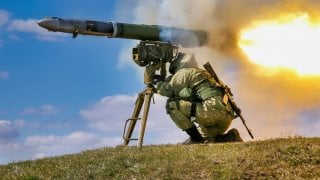Russia's Kornet Missile is the 'Tank-Killer' NATO Freaks Out Over
The 9M133 Kornet is Russia’s premier anti-tank guided missile (ATGM), developed in the late 1980s to rival Western armor. Boasting a range of up to 3.4 miles—extended to 6.2 miles in newer variants—this laser-guided missile features a tandem high-explosive anti-tank (HEAT) warhead designed to defeat explosive reactive armor.
Summary and Key Points: The 9M133 Kornet is Russia’s premier anti-tank guided missile (ATGM), developed in the late 1980s to rival Western armor. Boasting a range of up to 3.4 miles—extended to 6.2 miles in newer variants—this laser-guided missile features a tandem high-explosive anti-tank (HEAT) warhead designed to defeat explosive reactive armor.
-Widely exported and used in conflicts such as the 2006 Lebanon War and the Syrian Civil War, the Kornet has proven its effectiveness against heavily armored vehicles, including Western-supplied tanks.
-This weapon highlights Russia’s strategic focus on leveling the battlefield by arming light infantry with advanced anti-tank capabilities.
Russia’s Kornet Anti-Tank Missile, Explained
The 9M133 Kornet is the best Russian-made anti-tank missile system out there. It’s one of the best overall anti-tank weapons in the world. The Kornet is the result of decades of learning and was first introduced in 1988. The Kornet has demonstrated its ability to stymie enemy Main Battle Tanks such as the M1 Abrams MBT.
The Soviet Union developed this missile to maintain technological parity with rapidly advancing Western armor warfare capabilities. It was meant to replace older Soviet-era systems such as the 9K111 Fagot and 9K113 Konkurs.
The Specs
This system offered enhanced range, penetration capabilities, and operational flexibility. Its design philosophy reflects the strategic shift in modern armies away from engaging hitting enemy armor in a tit-for-tat-style engagement and toward engaging enemy armor at longer ranges.
Today, this anti-tank system is augmented by anti-tank drones, which have completely upended classical theories of maneuver and mechanized warfare.
Russia’s Kornet missile is a man-portable anti-tank guided missile (ATGM) system, but its versatility allows for vehicle-mounted configurations, too. The Kornet has a Semi-Automatic Command to Line-Of Sight laser beam-riding guidance system. In other words, the Kornet operator has to maintain line-of-sight on the target for the duration of the missile’s flight, allowing for significant accuracy when compared to some other anti-tank systems.
A Kornet’s range can go up to 3.4 miles. Newer variants like the Kornet-EM introduced in 2015, push this range up to 6.2 miles. Thus, the Kornet missile is one of the longest-range man-portable ATGMs in the world.The Kornet-D variant allows for vehicle mounting.
The missile contains a tandem high-explosive anti-tank (HEAT) warhead that is meant to overcome an enemy tank’s explosive reactive armor. And the design of this HEAT warhead means it can penetrate some of the thickest armor in the world, notably the frontal armor of enemy MBTs.
The Kornet Missile’s Many Uses
One of the Russian Federation’s primary exports is their immense armaments arsenal. Moscow regularly sells the Kornet to a variety of clients around the world.
These weapons are used with lethality not only in Ukraine, but by Hezbollah during their 2006 war with neighboring Israel, where the Kornet missiles proved able to penetrate heavily armored Merkava tanks).
Kornet missiles have also been used throughout the Syrian Civil War, where they target Western-supplied armored vehicles.
The long use of these missiles by multiple nations over many decades shows Russia has crafted a truly potent, world-class anti-tank weapon. Further, the development of this system by Russia gives insight into Russia’s overall strategic doctrine, emphasizing the use of advanced ATGMs to offset potential numerical disadvantages in armored forces.
Giving light infantry these systems effectively levels the playing field against technologically superior enemies.
Author Experience and Expertise: Brandon J. Weichert
Brandon J. Weichert, a National Interest national security analyst, is a former Congressional staffer and geopolitical analyst who is a contributor at The Washington Times, the Asia Times, and The-Pipeline. He is the author of Winning Space: How America Remains a Superpower, Biohacked: China’s Race to Control Life, and The Shadow War: Iran’s Quest for Supremacy. His next book, A Disaster of Our Own Making: How the West Lost Ukraine, is due October 22 from Encounter Books. Weichert can be followed via Twitter @WeTheBrandon.
All images are Creative Commons or Shutterstock.
From the Vault
Russia Freaked Out: Why the U.S. Navy 'Unretired' the Iowa-Class Battleships
Battleship vs. Battlecruiser: Iowa-Class vs. Russia's Kirov-Class (Who Wins?)


